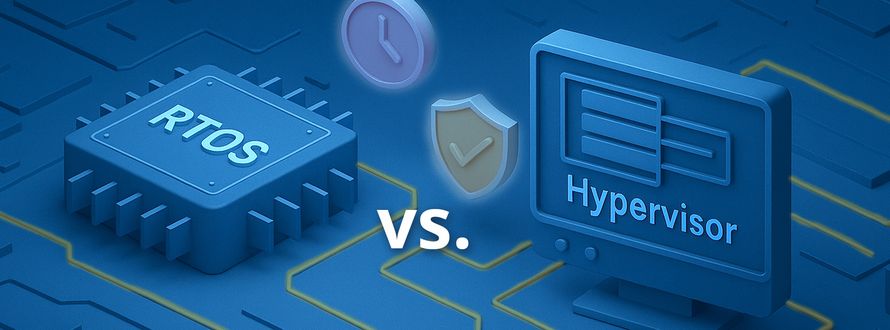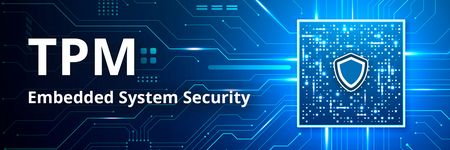
Navigating the Embedded Landscape: RTOS vs. Hypervisors
– PikeOS, Safety, SecurityThe expanding embedded Frontier
Embedded systems are everywhere—from automotive ECUs and aircraft control systems to industrial robots and medical devices. These systems span a broad spectrum—from simple connected devices to mission-critical platforms—and increasingly integrate networking, processing, and control functions.
While many embedded systems still operate under tight resource constraints and perform straightforward tasks, there's a growing segment—especially in safety- and security-critical domains—where deterministic timing, isolation, and certification are essential. This segment is particularly relevant in industries like automotive, aerospace, rail, and industrial automation.
Traditionally, embedded systems were purpose-built, often running simple firmware or a Real-Time Operating System (RTOS) tailored to a single function. However, the demands on embedded platforms have evolved. With the convergence of IoT, edge computing, functional safety, and cybersecurity, systems are becoming more complex and multi-functional. Today, a single embedded device may need to support multiple software domains—each with different levels of criticality and requirements—on shared hardware. This is where RTOS and Hypervisors become essential tools for achieving performance, separation, and safety.
Real-Time Operating Systems (RTOS): Determinism meets Efficiency
An RTOS is designed for predictable, real-time behavior. It ensures that high-priority tasks execute within a guaranteed time frame—an essential requirement for systems where delays can lead to failure (e.g., braking systems in vehicles or control loops in industrial automation).
Key Features of an RTOS:
- Deterministic Scheduling: Often using fixed-priority or round-robin scheduling to guarantee timing constraints
- Lightweight Footprint: Designed to run on microcontrollers with limited RAM/CPU
- Fast Context Switching: Optimized for performance on constrained hardware
- Minimal Latency: Ideal for hard real-time applications
Common RTOS Use Cases:
- Automotive ECUs: Powertrain control, braking systems
- Medical Devices: Infusion pumps, pacemakers
- Industrial Control: PLCs, motor controllers
- Consumer Electronics: Smart thermostats, fitness trackers
Popular RTOSes include FreeRTOS, Zephyr, and SYSGO's PikeOS.
Hypervisors: Isolation, Consolidation, and Security
A hypervisor enables multiple operating systems to run simultaneously on a single hardware platform. In embedded contexts, this allows mixing different workloads—some critical, some general-purpose—while ensuring isolation between them.
There are two types of hypervisors:
- Type 1 (bare-metal): Runs directly on the hardware and manages guest OSes (SYSGO's PikeOS is a type-1 hypervisor)
- Type 2: Runs on top of a host OS, generally less common in embedded settings
Key Benefits:
- Strong Isolation: Faults or security breaches in one guest OS do not impact others
- Mixed-Criticality: Supports both safety-critical and non-critical tasks on one platform
- Hardware Consolidation: Reduces BOM by running everything on a single SoC (System-on-a-Chip)
- Certification and Compliance: Facilitates system partitioning for safety standards (ISO 26262: Automotive, DO-178C: Avionics, EN 50128: Railway, IEC 61508: Industrial Automation)
Hypervisor Use Cases:
- Automotive Domain Controllers: Running infotainment, telematics, and ADAS on the same ECU, quick bring-up of CAN data
- Aerospace Systems: Combining flight control with navigation and mission management
- Industrial Gateways: Running real-time control alongside edge analytics and connectivity stacks
- Medical Imaging Devices: Separating imaging pipelines from general OS environments
RTOS vs. Hypervisor: When to use which?
Choosing between an RTOS and a hypervisor depends on application complexity, functional safety levels, isolation requirements, and resource availability.
Requirement | Use RTOS | Use Hypervisor |
| Hard real-time performance | ✓✓ | ✓ (if configured correctly) |
| Low footprint | ✓ | ✗ (hypervisors add overhead) |
| Mixed-criticality | ✗ | ✓ |
| Safety certification | ✓ (depends on RTOS) | ✓✓ (stronger support, e.g., PikeOS) |
| Secure isolation | ✗ (limited) | ✓✓ |
| Software reuse | ✗ (often monolithic) | ✓ (legacy OS reuse possible) |
A quick Decision Guide for Engineers
Choosing between an RTOS and a Hypervisor can seem complex, but it often comes down to a few practical questions:
Choose an RTOS when:
- You need hard real-time performance with minimal latency
- Your system has limited resources (RAM, CPU, Flash)
- You're developing a single-purpose embedded device
- Your project does not require secure isolation between software tasks or features
- Certification is required, but the system is monolithic and relatively simple
Example: A microcontroller-based motor controller with strict timing and no connectivity requirements.
Choose a Hypervisor when:
- You want to run multiple operating systems (e.g., RTOS + Linux)
- You need to combine safety-critical and non-critical functions on one device (also called mixed criticality)
- Your system must be secure, with strong isolation between software domains or functional applications, as well as execution time allocation per partition to the processor
- You're targeting a multi-core SoC and want to consolidate hardware
- You’re reusing legacy software that was built for another OS or hardware platform
Example: An automotive domain controller running Linux for infotainment and a real-time OS for vehicle control on the same processor.
Challenges and modern Solutions
1. Security and Isolation
As embedded devices are more and more connected (IoT, V2X), security becomes paramount. Traditional RTOS environments often lack robust memory protection and isolation.
Solution: Hypervisors provide robust separation of domains. PikeOS includes a separation kernel architecture and supports MILS (Multiple Independent Levels of Security).
2. Certification Bottlenecks
Achieving compliance with safety standards is time-consuming and expensive, especially when consolidating complex systems.
Solution: Platforms like SYSGO's PikeOS are pre-certified to safety standards like ISO 26262, EN 50128 and DO-178C. Its architecture allows modular certification, reducing cost and time-to-market.
3. Legacy Software Integration
Many industries (like aerospace, industrial or rail) have legacy software written for older platforms. Migrating to modern RTOSes can be costly.
Solution: Hypervisors allow legacy operating systems to run as "guest systems" within isolated virtual environments, enabling the reuse of existing software without the need to rewrite or significantly modify the original code. PikeOS supports guest OSes like Linux, Android, RTEMS, Windows, or even classic RTOS environments.
4. Scalability and Maintenance
Scaling RTOS-based systems across product lines can lead to maintenance nightmares due to code divergence.
Solution: Hypervisors decouple hardware dependencies from application logic. With PikeOS, virtualized environments can be updated independently and reused across platforms.
The Role of SYSGO and the Power of PikeOS
In safety- and security-critical embedded systems, the challenge is no longer just performance or functionality—it’s doing more with less: fewer chips, tighter certifications, and broader functionality across domains. This is where SYSGO’s PikeOS stands out.
What is PikeOS?
PikeOS is a real-time operating system combined with a hypervisor, based on a separation kernel architecture. It’s purpose-built to support mixed-criticality systems, enabling developers to run time-sensitive applications alongside general-purpose software on the same hardware—without compromising isolation, performance, or certification.
Why combine Hypervisor and RTOS?
Most hypervisors offer good isolation but fall short on real-time guarantees. Traditional RTOSs offer great timing, but lack the flexibility and separation needed for modern, multi-functional systems.
PikeOS merges both worlds:
- Real-time scheduling for time-sensitive applications.
- Partitioning for security and fault containment.
- Guest OS support to run Linux, legacy RTOSs, or bare-metal code.
- Certifiability across aviation, automotive, rail, and industrial domains.
This makes PikeOS ideal for projects that demand strong isolation, legacy reuse, and functional safety, such as:
- Automotive domain controllers (ISO 26262)
- Avionics control and communication systems (DO-178C)
- Space systems requiring fault tolerance and real-time response (ECSS standards)
- Railway signalling systems (EN 50128)
- Industrial controllers (IEC 61508)
Technical and Business Benefits
- Security-first design with MILS-style architecture
- Simplified system consolidation, reducing hardware complexity
- Pre-certification artifacts, speeding up time-to-market
- Multi-core support (SMP and AMP) for modern SoCs
- Broad hardware support: ARM, x86, PowerPC, RISC-V
In Short:
PikeOS doesn’t force you to choose between an RTOS or a hypervisor—it gives you both in one product, tightly integrated and optimized for the most demanding embedded applications.
Future Outlook: Convergence, AI, and Edge Computing
The embedded industry is moving toward heterogeneous integration—combining CPUs, GPUs, and accelerators on single chips. With this, both RTOS and hypervisors will evolve:
- AI at the Edge: Safety-certified inference engines will require real-time environments alongside general-purpose Linux
- 5G and TSN (Time-Sensitive Networking): New networking standards demand deterministic yet flexible processing stacks
- Dynamic Partitioning: Future hypervisors may enable real-time reconfiguration of resource allocations
- Open Standards: Initiatives like AUTOSAR Adaptive, OP-TEE, and RISC-V will reshape the stack with open architectures
In this world, solutions like PikeOS are uniquely positioned. By combining hypervisor-based isolation with real-time scheduling and safety certification, they offer a blueprint for building next-generation embedded systems—secure, scalable, and ready for the future.
-
Previous
-
Next

 Twitter
Twitter LinkedIn
LinkedIn Facebook
Facebook Reddit
Reddit RSS
RSS Copy link
Copy link
